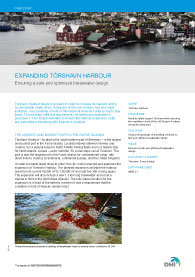
Tórshavn Harbour in the Faroe Islands is a popular base for North Atlantic fishing fleets and North Atlantic cruises, with 50 cruise ships calling there every summer. It is also the largest port in the Faroe Islands for containerised cargo.
To ensure larger ships could enter, the city council planned and approved the expansion of Tórshavn Harbour. The expansion will include a new 1.3 km long breakwater that will cover a new marina in front of the old fortress Skansin.
A requirement of the expansion, however, was that the coastline in front of Skansin had to remain intact. To help designers test and optimise their design, we analysed 34 years of hindcast data from two numerical models in order to determine the expected wave height with a return period of 100 years. A detailed MIKE 21 Spectral Waves (SW) model was used to transform the offshore waves to the site. Based on design waves from the hindcast data, we provided detailed guidance on the design of the breakwater.
We modelled wave disturbance for the existing harbour and two alternative layouts of the harbour extension using MIKE 21 Boussinesq Waves (BW). To determine the effect of the waves on moored ships, we carried out ship motion modelling using our numerical model WAMSIM. The models confirmed that the movements of ships at the new quays will be comparable to the movements at the existing quays.
Using two-dimensional (2D) physical modelling, we optimised the design of the breakwater – with the client – by testing and confirming the benefits of densely packing the armour stones. We also tested a steeper slope of the breakwater, which proved stable and thus significantly reduced the amount of material needed.
Using a three-dimensional (3D) physical modelling of the northern breakwater head at the entrance to the marina, we tested an updated design using larger armour stones in this area, while reducing the size of armour stones in other past of the breakwater. This enabled the creation of a safer design that did not use unnecessarily large stones in less exposed parts of the breakwater.